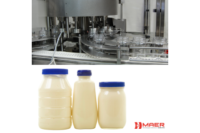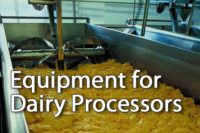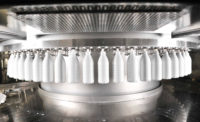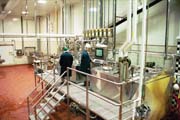
The people at Ben & Jerry's say it's different from other ice cream companies, and that part of that difference is an extraordinary sense of responsibility to the greater community.
That bottom line at the Burlington,Vt. headquarters has as much to do with "doing the right thing," as it has to do with profit and loss. The same people will say that the core mission at Ben & Jerry's has not changed since the company has been under the parentage of corporate giant Unilever.
If one accepts these notions, it's easy to see why a consolidation of operations at Ben & Jerry's had the potential to become a public relations nightmare. Closing facilities and eliminating jobs to maximize efficiencies? Where's the love?
Turns out, Ben & Jerry's was able to sell those facilities rather than shuttering and gutting them, so there may now be more ice-cream related jobs in Vermont than there were before the changes were implemented. Also, by reducing the greatest distance between facilities from about 180 miles to about 50 miles, the company is also reducing its truck traffic (and the related Co2 emissions) to the tune of a million miles a year.
With the risks to Ben & Jerry's reputation having been mitigated, the company is now basking in the outcome. At the center of the more efficient operation is the newly-expanded plant in St. Albans, just a stone's throw from the company's milk source--St. Albans Cooperative.
"It's a pretty standard receiving bay," says Drake Wallis, director of manufacturing as he shows Dairy Foods around the plant during a recent visit. Indeed, it's a rather ordinary, two-bay drive-through. "But they just drop the trailer. Their operation is so close, that we just call them when it's finished and they can come back and get it."
The co-op's "rBGH-free" milk is the only milk Ben & Jerry's uses. The proximity to that source is what drove the company to build its third plant where it did, and it contributed to the decision to turn its newest plant into its largest. Stahlman Engineering, New London, N.H., was the A&E firm that worked with Ben & Jerry's to design and build the expansion.
The plant is also producing the mix for a new line of all-organic products that includes signature flavors like Cookies and Cream. The organic line is currently in test markets and will roll-out next year.
Expansion Details
A new production line, an addition to a spiral freezer, and a massive new warehouse, are the central elements of the $10 million, 45,000 sq ft expansion project that began last fall. The new production line was running product by April, and the spiral and the warehouse were completed in June and August respectively.St. Albans is now the dispatch point for all Ben & Jerry's production, handling a minimum of 18 truckloads a day from on site and from the Waterbury, Vt. plant.
The project also included re-piping of the pasteurized milk silos, and a simplification of the entire plant's CIP system.
"We were able to eliminate about 3,000 ft. of 3-inch pipe," says Pete Gosselin, director of engineering. "That in turn eliminates thousands of gallons of wastewater and CIP solution on a daily basis."
The St. Albans plant is just nine years old, and yet there was room for improvement in the new processing room.
"In the existing areas there is a lot of piping on the floor," Gosselin says. "Now we've got more of the piping and valve clusters up on a wall, which makes maintenance a lot easier."
Similar thinking was applied to controls. The new area features a walk-on ceiling that houses the control hardware. Four touch-screen control panels are suspended from the ceiling on swing arms. All four are redundant so that any of the components on the line can be operated from any of the panels. The new production room is also outfitted with a hepafiltration system that produces a positive airflow, reducing hot and cold spots in the room.
The spiral freezer consists of two barrels that are each 35 feet tall. A 70 mph wind at -35?F hardens the product in about eight hours. The spirals are used for both pints and for the 2.5-gal. bulk containers bound for Ben & Jerry's scoop shops. The spiral was built on an extended footprint, so that it can be expanded exponentially as needed.
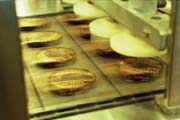
Rapid Growth
Ben & Jerry's broke ground on the St. Albans plant in 1993 and it was operational a little over a year later. For a young plant it has undergone a nearly continuous succession of line expansions and modifications. A third line was added to the original two in 1997, allowing for a larger array of package configurations. A year later, one of the lines was re-fitted with a specially modified dual filler to run the Two Twisted product line. Two twisted flavors like Half Baked, and Everything But The, feature a different base flavor on either side of the carton, along with variegates and inclusions throughout.In 1999, a line modification put such a squeeze on floor space that a vat was built on top of a freezer. "We had to get quite creative," Wallis says.
The plant now has four lines that run five days a week, year round. There are six raw milk silos, and four pasteurized silos that hold 12,000 gals each. Milk is processed with Alpha Laval equipment and sent to a batch room that features a new automated control system. Employees now mix each batch with a control system that is linked to a central recipe data base. Any modifications made to recipes are implemented immediately and simultaneously at both production facilities. Wallis says this is part of an ongoing effort to produce a more consistent product.
Production freezers include one Tetra Pak Hoyer machine and three from APV. Pints are filled with four-wide fillers. The new fourth line is currently used for filling bulk tubs.
After the pints are hardened, tamper-evidence bands are shrink applied and the pints are then bundled in sleeves of eight. A visual inspection system rejects non-uniform sleeves before those that conform to specs are sent to the palletizing area.
Currently one line is outfitted with an automated palletizer while pallets on the other lines are built by hand. And this is where the next phase of improvement will take place. In 2004, three more automated palletizers will be added. "By 2005 we'll automate the warehouse to a complete lights-out operation, " Wallis says.
Philosophy and Flavor
The Ben & Jerry's lore goes back 25 years to when two schoolmates from Long Island opened a scoop shop in a former gas station in Burlington. Back then, they simply called it Vermont's Finest Ice Cream.Along with its uncommon social mission, Ben & Jerry's has served up some uncommon ice cream--rich, and dense, with loads of butterfat and lots of chewy and gooey stuff. The company helped invent the superpremium category and set new standards with its inclusion-rich ice cream and unusual flavors names.
These two aspects of the company are alive and well at the St. Albans plant. For example:
- Wallis notes that although standard processing and filling equipment is used at the plant, most of it has been highly modified to accommodate big chunks of fruit or cookies and disperse them evenly.
"We get some pretty crazy ideas from our R&D team and we never say no," he says. "We always try to meet the challenge."
- When that R&D team developed Phish Food, a chocolate marshmallow and nut combo, there was a problem finding a marshmallow that had the right consistency. The eventual solution? Make the marshmallow in house. The plant now has a machine that makes marshmallow.
- Painted footprints direct plant personnel to recycling stations as part of a program designed to achieve nearly 100% recycling or reuse of packaging .
- Even the outside of the building has a special flare. There are pink flamingos along a water retention pond, and the familiar black and white check pattern found on Ben & Jerry's packaging adorns the outside and inside of the plant.
Not surprisingly, the plant also fosters the kind of progressive business practices you would find at any good operation.
"A lot of what we've done is the result of good planning," Gosselin says. "As an example, it's resulted in a paradigm shift in how we approach CIP. We use the teamwork approach, and it has led to a more efficient, simplified CIP system."
As the tour concludes, the group passes through a hallway adjacent to a courtyard between two sections of the building. It's a hot, sunny day, and a portable sprinkler system is dousing a number of small trees that were planted after the expansion.
"The trees should help reduce Co2, too, " Wallis says as he heads back to his office.
Plant Facts
Location: St. Albans, Vt.Plant Size: 138,000 sq ft
Site: 42.5 acres
Products: Ice cream, soft serve, frozen yogurt
Production: 250,000 gals per week
Plant Mgr.: Drake Wallis, dir. of manufacturing
Employees: 215
St. Albans Crucial to B&J's New Distribution Strategy
The newly-expanded St. Albans plant is strategically located near the company's milk source, but its proximity to distribution lanes is another reason why it has become the hub of the company's operations.Historically, Ben & Jerry's products have been distributed to retailers through an arrangement with Dreyer's Grand Ice Cream, Oakland, Calif. But with Dreyer's having recently merged with Nestle, and with Ben & Jerry's being part of Unilever Corp., distribution is now a coordinated effort for Good Humor-Breyer's and Ben & Jerry's, the two major components of Unilever's North American ice cream operations.
The sale of Ben & Jerry's Springfield plant and distribution facility, and the consolidation of operations in northern Vermont have made distribution more efficient, says Drake Wallis, Ben & Jerry's dir. of manufacturing.
"All the Ben & Jerry's product now comes through our warehouse before being sent to eight different distribution centers across the country," he says. "We are sending out a lot less mixed loads now."
Even the location of the St. Albans plant has led to greater efficiencies.
"We're much closer to the major distribution lanes now," Wallis says. "So when trucks leave here they get right on the interstate rather than having 100 miles of secondary roads to contend with."
In addition, Ben & Jerry's does a good deal of overseas business, and shipping containers are now filled much closer to their port destination in Canada, and no longer have to be double-handled.
"We're only about an hour away now," Wallis says.
